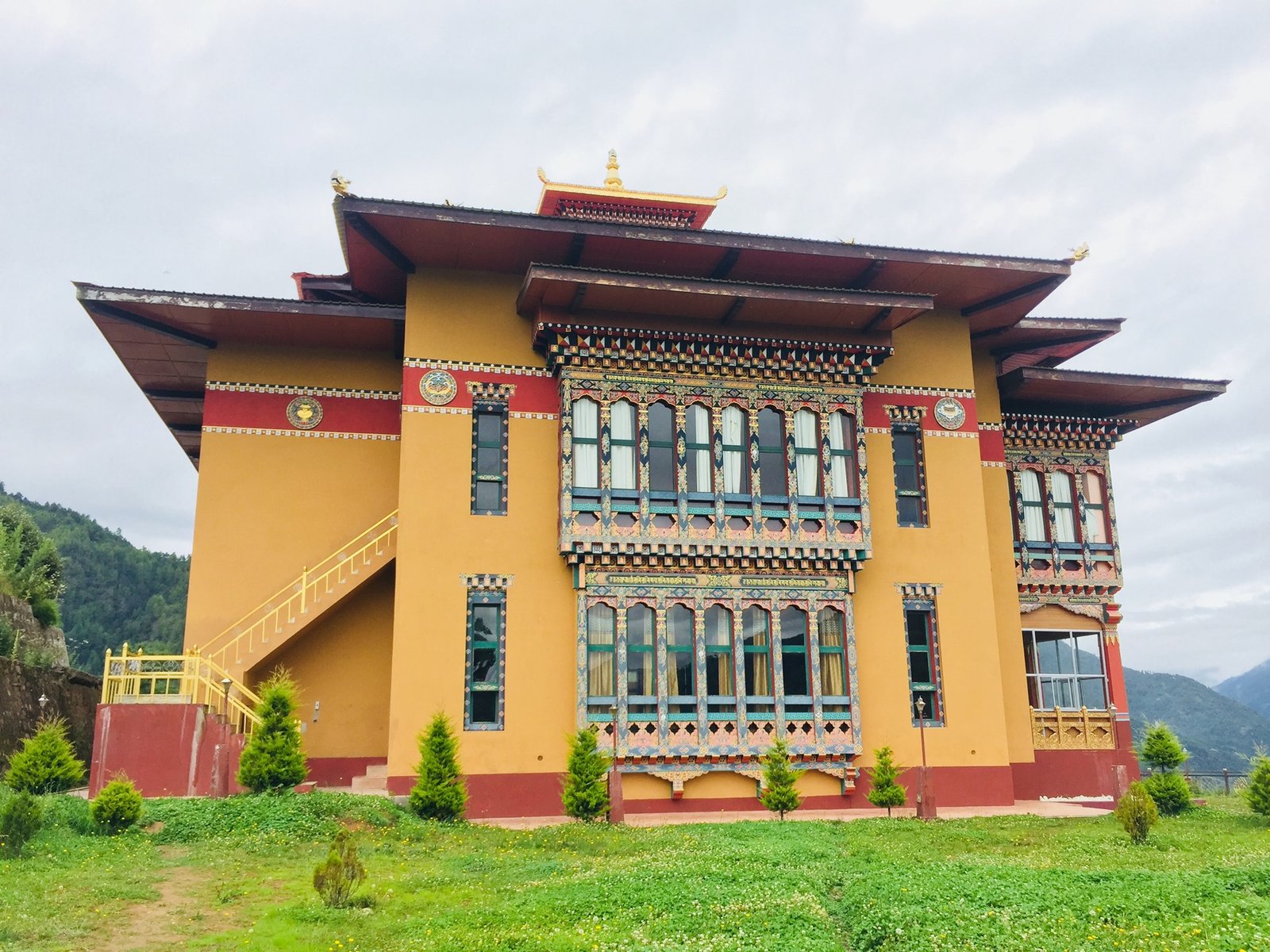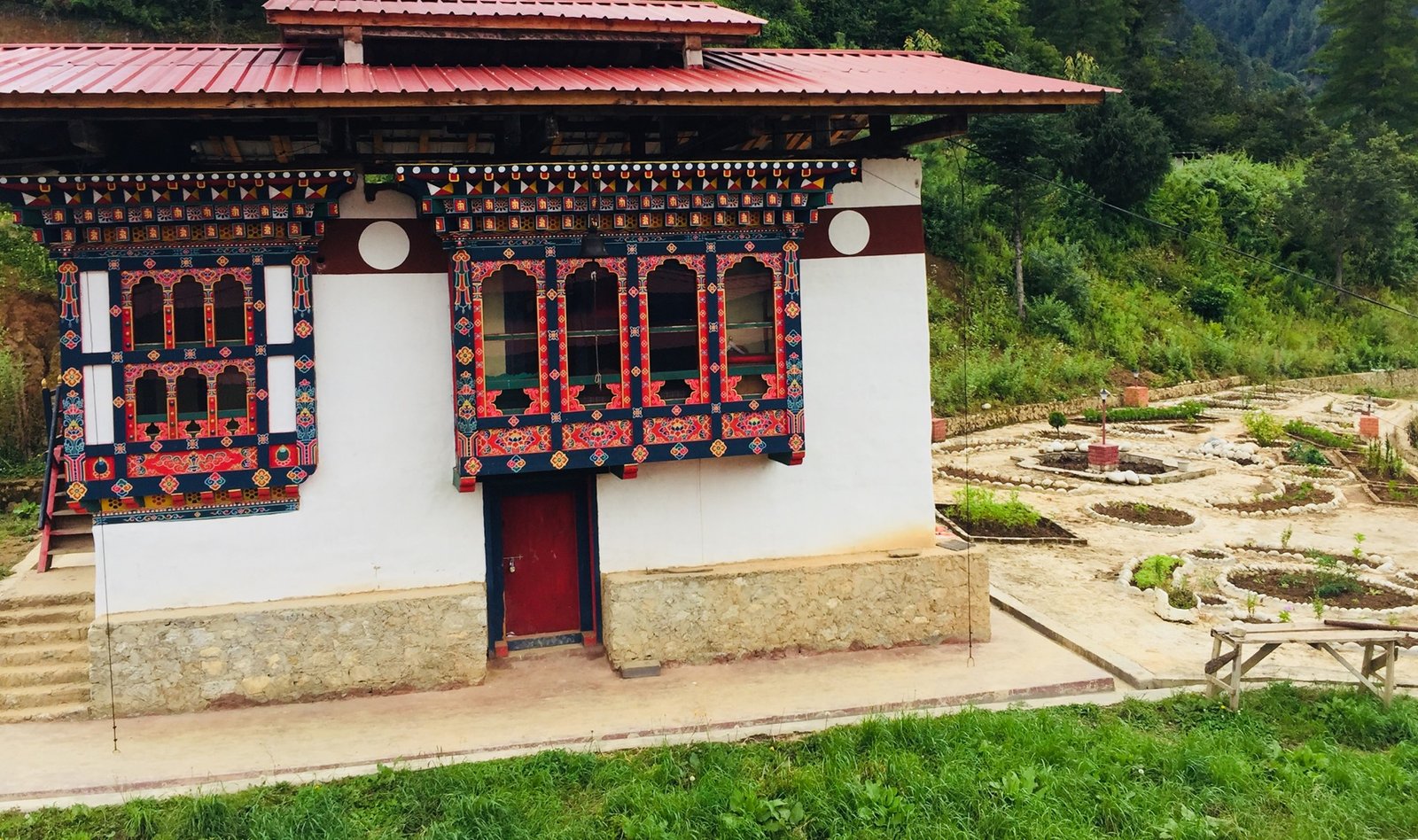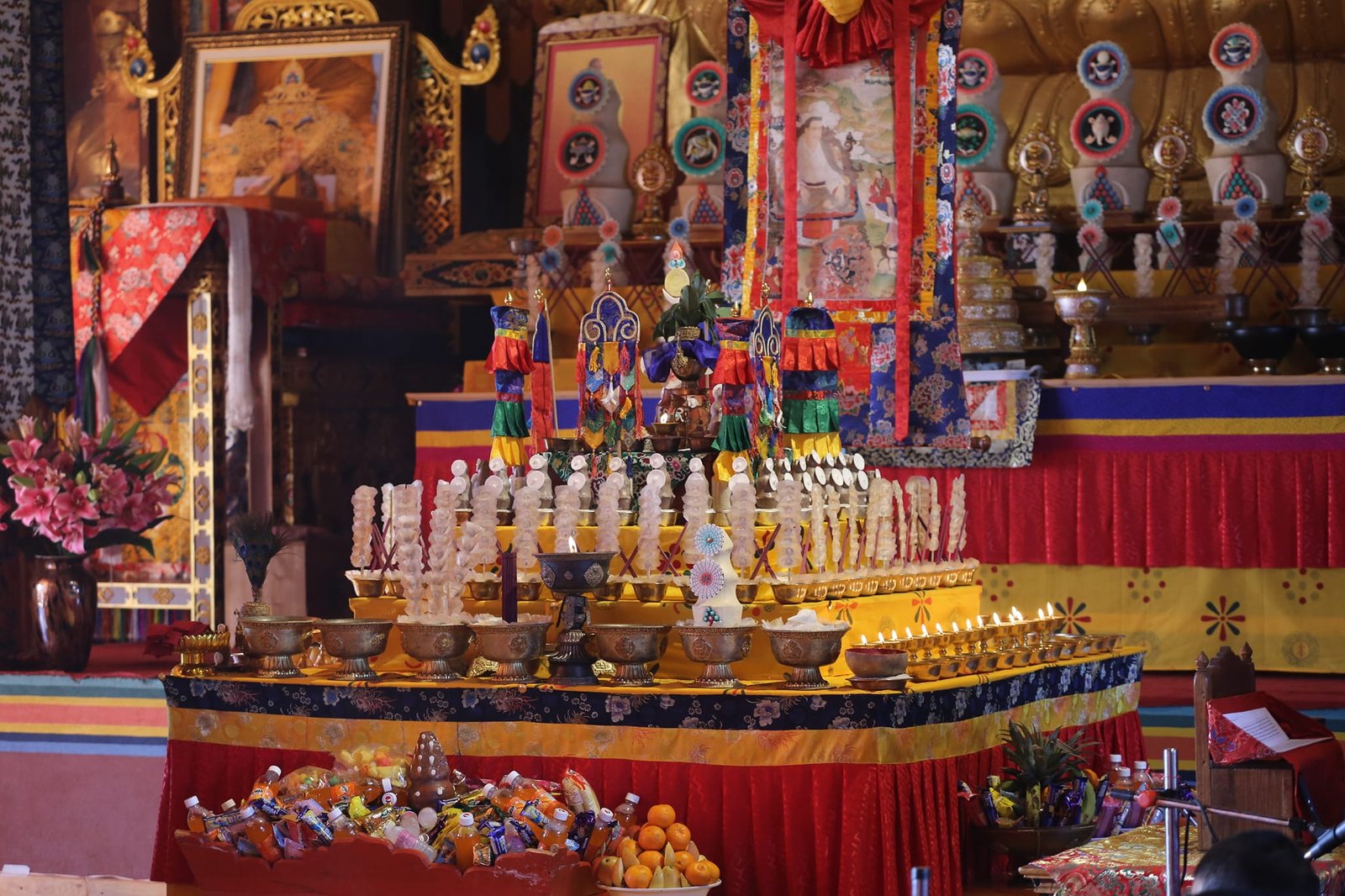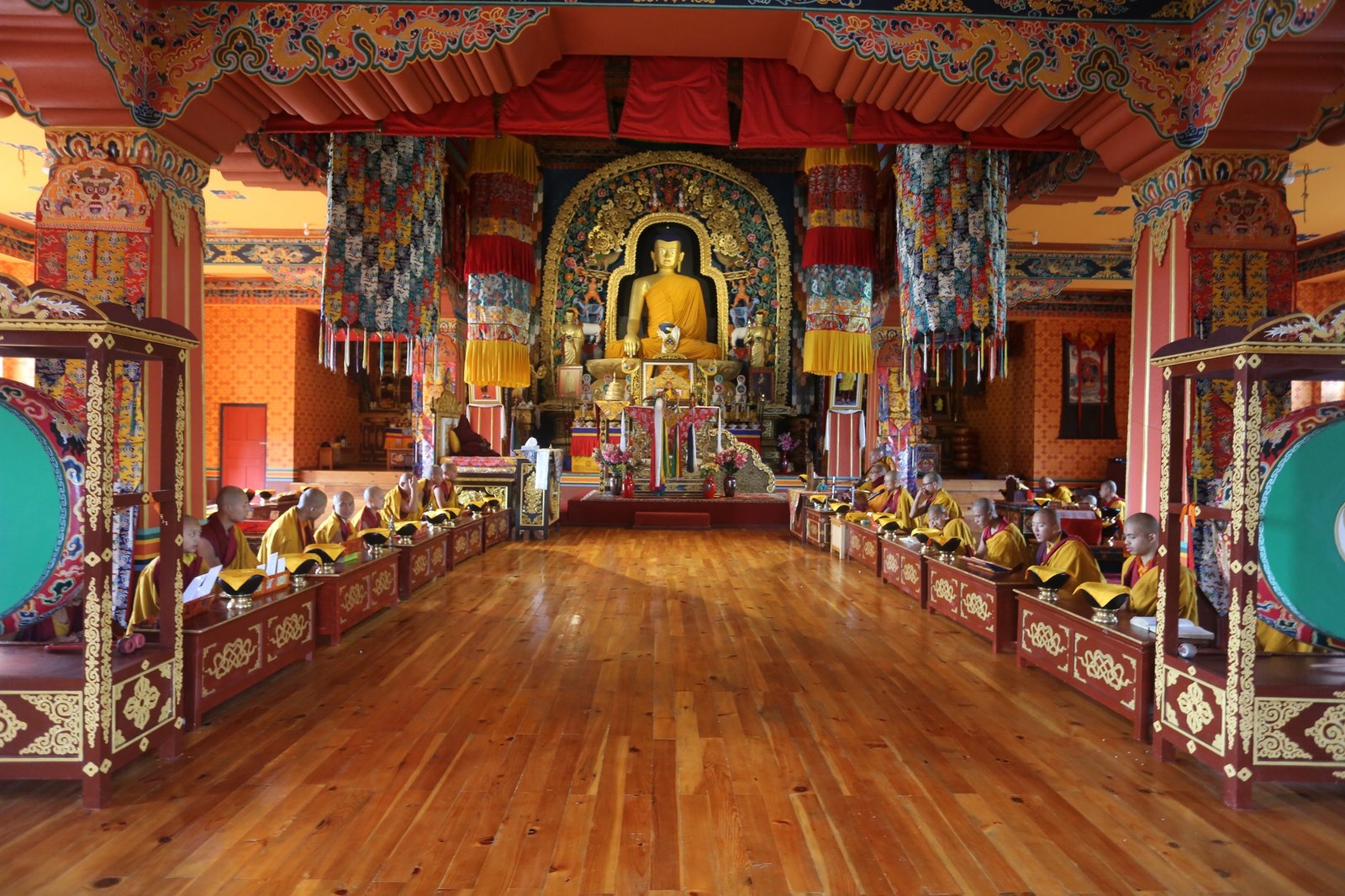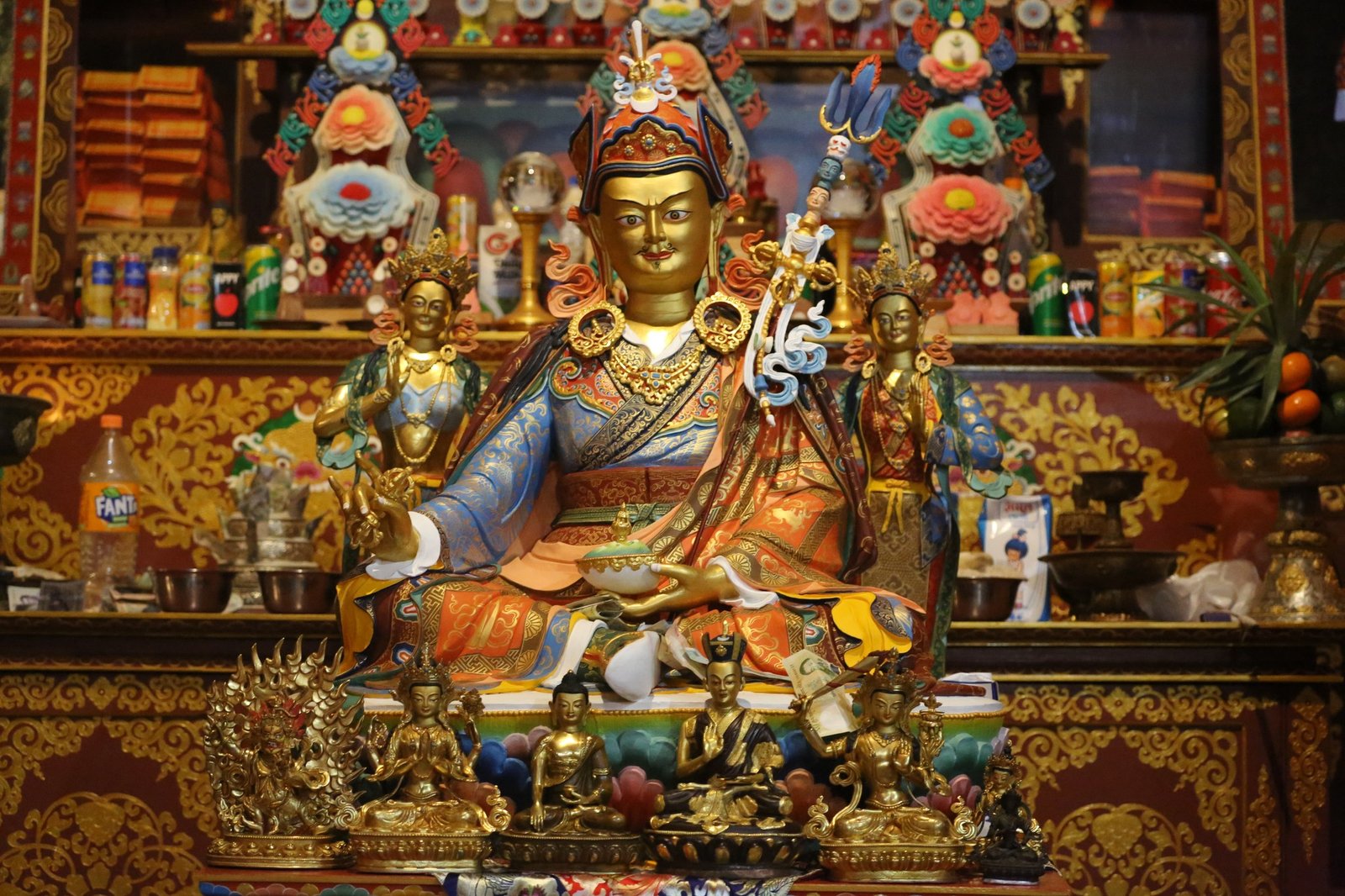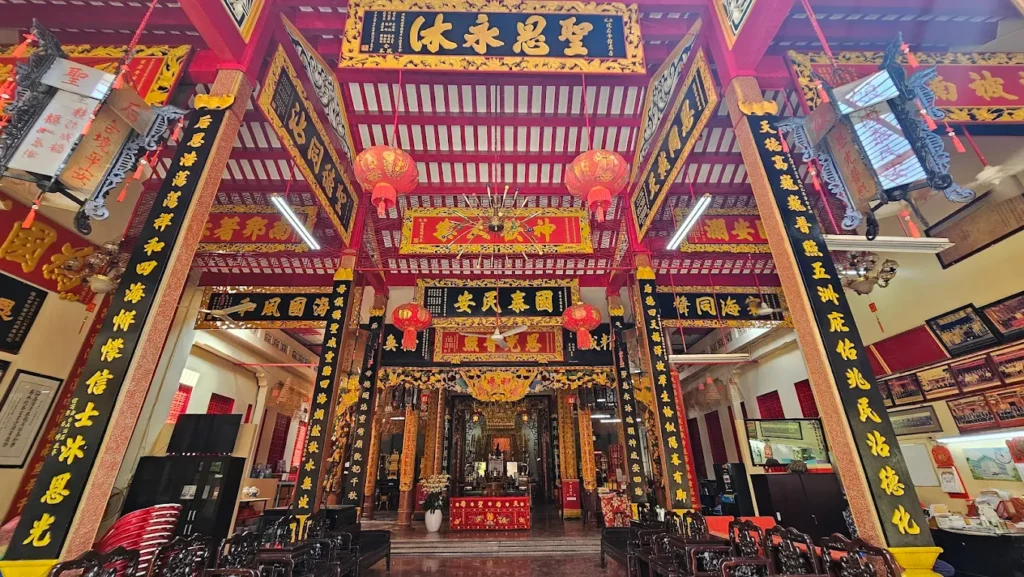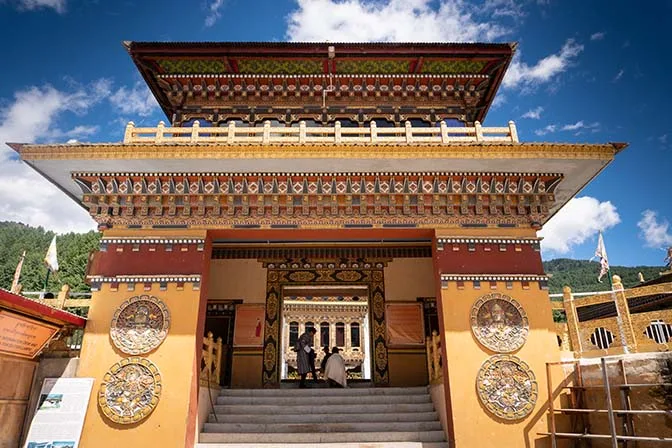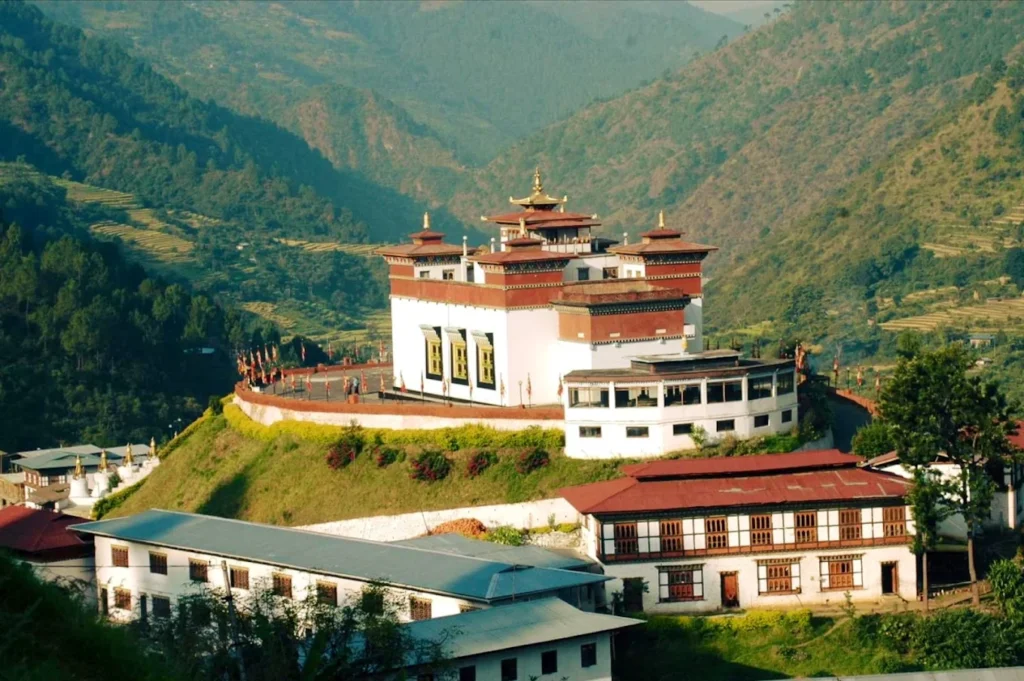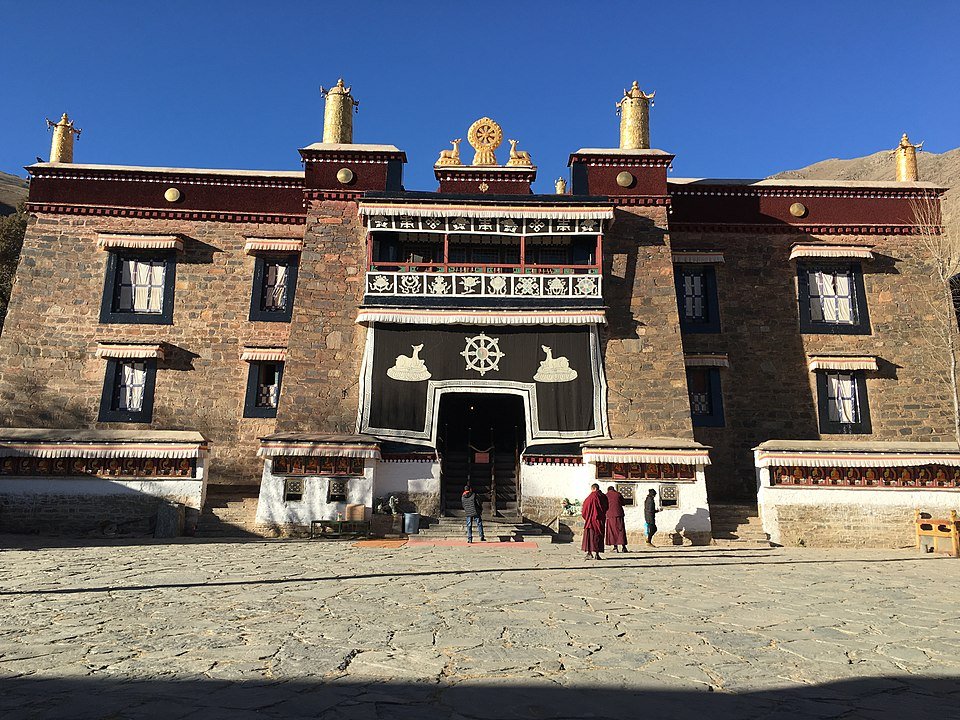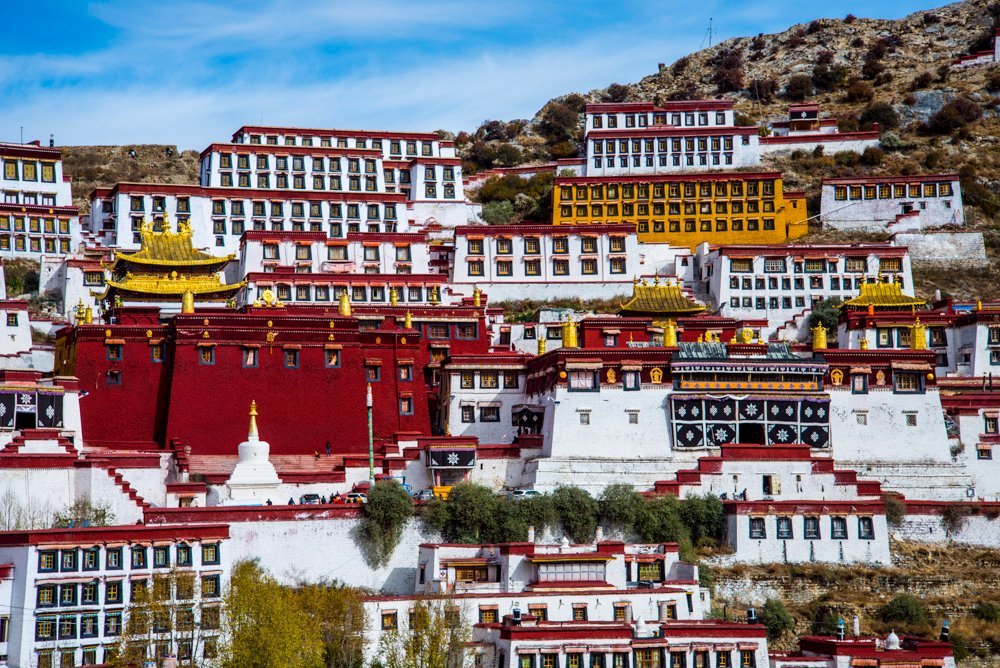Taklung Monastery: Kagyu Sanctuary of Paro’s Sacred Valley
As dawn pierces the mist of Paro Valley, Taklung Monastery awakens on a ridge resembling an elephant’s nose, its whitewashed walls aglow against the Himalayan dawn. Within, a towering bronze Shakyamuni Buddha stands beside Guru Rinpoche (Padmasambhava) and Gampopa, their forms framed by vibrant Karma Ghadri murals, as butter lamps flicker with the hum of monks’ chants. Across the valley, Paro Taktsang’s cliffs rise, a sacred counterpart to Taklung’s meditative calm. During Tshechu, masked dancers swirl in the courtyard, their steps weaving the Taklung Kagyu lineage’s ancient rhythms. Founded in 2010 by Taklung Rinpoche, with the blessing of His Holiness the 17th Karmapa Ogyen Trinley Dorje, this monastery near Paro Kyichu Temple serves Paro’s Sharchop community as a retreat center. Perched in Paro’s highlands, it blends Mahamudra meditation with Bhutanese artistry, offering a sanctuary where spiritual heritage meets alpine serenity.
Overview and Significance
Taklung Monastery, rising on a ridge in Paro Valley, stands as a modern beacon of the Taklung Kagyu lineage, its golden roofs and prayer halls echoing the sanctity of nearby Paro Taktsang. This monastery weaves meditation, scholarship, and community, anchoring Bhutan’s Kagyu heritage.
Introduction to Taklung Monastery
Taklung Monastery, formally Taklung Wosel Jewai Ling, crowns a mountain ridge in Paro’s Dopshari Gewog, its whitewashed walls and red-tiled roofs a testament to Kagyu Buddhism, a lineage tracing from Tilopa through Gampopa’s Mahamudra teachings. Founded in 2010 by Taklung Rinpoche, guided by a vision blessed by the 17th Karmapa, it serves as a monastic hub and retreat center for Paro’s Sharchop villagers. Its prayer halls, adorned with Karma Ghadri murals, face the sacred cliffs of Paro Taktsang, fostering enlightenment through chant and contemplation. Near Paro Kyichu Temple, it unveils Bhutan’s Kagyu soul.
Historical Journey
The monastery’s story unfolds in Paro’s modern era:
- Vision (2010): Taklung Rinpoche, inspired by Paro’s sacred landscape, sought the 17th Karmapa’s blessing to establish the monastery.
- Founding: Named Taklung Wosel Jewai Ling, it was built as a Kagyu retreat, drawing monks and laity.
- Construction: Completed with traditional Bhutanese wood and stone, it mirrors Paro’s architectural heritage.
- Legacy: Continues the Taklung Kagyu tradition, rooted in Tashi Pal’s 12th-century teachings.
Cultural Significance
The monastery shapes Paro’s spiritual fabric:
- Kagyu Stronghold: Transmits Mahamudra, guiding meditative practice.
- Community Core: Tshechu unites Paro’s Sharchop villagers in devotion.
- Sacred Proximity: Its Taktsang-facing ridge enhances its sanctity.
Unique Legacy
Its modern founding and cliffside perch define Taklung’s spiritual identity.
Community and Global Impact
- Local Ties: Educates monks and hosts village rituals, binding Paro’s community.
- Regional Draw: Attracts Kagyu practitioners from western Bhutan.
- Cultural Note: Inspires Bhutanese Kagyu pilgrimage traditions.
Historical Anecdotes
- Taklung Rinpoche’s vision aligned with Paro Taktsang’s sacred aura.
- The 2010 blessing by the 17th Karmapa drew Paro’s faithful to the ridge.
Social Role
Meditations and festivals knit spiritual and social threads in Paro.
Artistic Influence
Its Karma Ghadri murals inspire Paro’s thangka artisans.
The monastery’s history shapes its form, where chorten and murals frame a space of reverence.
Architectural and Spiritual Features
Taklung Monastery’s whitewashed halls and golden roofs blend Kagyu reverence with Bhutanese craft, its ridge overlooking Paro Taktsang’s cliffs. This section unveils its design and sacred spaces.
Iconic Design
The monastery’s stone walls, crowned with a red-tiled roof, rise on a ridge resembling an elephant’s nose at 2,800 meters. Its courtyard, fringed by prayer flags, gazes across Paro Valley, with a golden chorten catching the alpine glow.
Key Structures
- Main Prayer Hall (Lhakhang): A spacious chamber with vibrant Karma Ghadri murals and altars.
- Chorten: A golden stupa, a meditative focal point.
- Monks’ Quarters: A 2010 wing housing the monastic community.
- Meditation Cells: Small rooms for Mahamudra practice.
Worshipped Statues/Deities
- Shakyamuni Buddha: A towering bronze statue symbolizes enlightenment.
- Guru Rinpoche: Honors Bhutan’s Buddhist founder.
- Gampopa: Reflects Kagyu’s foundational teacher.
- Taklung Thangpa Tashi Pal: Commemorates the Taklung Kagyu founder.
Materials and Techniques
Stone walls and seasoned timber beams, with mineral-pigment murals, reflect Bhutanese artistry.
Signature Elements
The golden chorten and Shakyamuni statue anchor the monastery’s spiritual core.
Lesser-Known Features
- Kagyu Murals: Depict Tilopa and Gampopa in the prayer hall.
- Prayer Wheels: Line the courtyard, spun by monks and pilgrims.
Preservation Efforts
Since 2010, monks treat wood against Paro’s humidity, preserving murals.
Environmental Integration
The ridge perch ties the monastery to Paro’s cliffs, a tranquil retreat facing Taktsang’s sanctity.
Artisan Narratives
Paro carpenters carved beams, while Thimphu painters crafted Karma Ghadri murals, blending tradition.
Symbolic Details
The chorten signifies enlightenment; Gampopa murals evoke Kagyu lineage wisdom.
Landscape Integration
Paro Taktsang’s cliffs across the valley enhance meditative calm, grounding the monastery.
These spaces cradle the monastery’s rituals, inviting monks into Kagyu’s meditative rhythm.
Rituals and Practices
Taklung Monastery’s rituals, rooted in Taklung Kagyu’s Mahamudra, blend chant and meditation, fostering enlightenment. This section explores its ceremonial life.
Daily Sacred Rites
- Sutra Chanting: Monks recite Kagyu texts at dawn, filling the prayer hall.
- Offerings: Butter lamps and incense honor Shakyamuni and Gampopa.
- Meditation: Mahamudra sessions focus on the mind’s innate clarity.
Unique Practices
During Kagyu Monlam, monks craft torma (ritual offering) sculptures, offerings unique to the Taklung Kagyu lineage.
Festival Traditions
- Tshechu: In March or April, masked dances honor Tilopa and Gampopa, vibrant in Paro’s spring.
- Kagyu Monlam: Annual prayers for world peace, led by Taklung Rinpoche.
Visitor Engagement
Guests may join morning chants or Monlam prayers, guided by resident monks.
Spiritual Community Roles
Monks lead rites; Sharchop villagers organize festivals, fostering unity.
Interfaith Connections
Exchanges with Nyingma monks near Paro Taktsang reflect Bhutanese harmony.
Ritual Symbolism
- Torma: Sculptures symbolize impermanence, a Kagyu teaching.
- Butter Lamps: Light signifies wisdom piercing ignorance.
Seasonal Variations
Tshechu intensifies in spring; winter retreats deepen meditative practice.
Monastic/Community Life
Monks study Kagyu texts; villagers tend the courtyard, their work an offering.
These rituals guide visitors to the monastery’s philosophical depths.
Visitor Information
Taklung Monastery welcomes travelers to Paro’s highlands, offering practical details to engage with its sacred heart.
Navigating to Taklung Monastery
Near Paro Taktsang in Paro Valley, a 1-hour drive from Paro town via Dopshari Gewog leads to a ridge where the monastery’s golden chorten rises, 20 km from Paro’s center.
Address of Taklung Monastery
Paro Valley, Dopshari Gewog, Paro District, Bhutan
Visiting Hours and Etiquette
- Hours: Open daily from 7:00 AM to 5:00 PM, extended during Tshechu.
- Etiquette: Dress modestly, covering shoulders and knees; remove shoes in the prayer hall; avoid photographing altars.
Transport Options
- Car: A 1-hour drive from Paro town via taxi to Dopshari, then a 15-minute walk.
- Bus: Paro-Dopshari buses stop near the village, followed by a short trek.
- Hiking: A 30-minute trail from Dopshari through pine forests.
Accessibility and Safety
- Accessibility: The courtyard is flat; steps limit prayer hall access for those with mobility issues.
- Safety: Paro is safe, but carry water and warm clothing for the trek.
Amenities and Surroundings
Restrooms and benches in the courtyard; Dopshari village offers tea stalls and homestays.
Immersive Tips
Visit in March or April for vibrant Tshechu dances or join morning meditations for Kagyu insight.
Nearby Cultural Experiences
- Paro Taktsang: 5 km away, Bhutan’s iconic cliffside temple, a 2-hour trek.
- Paro Kyichu Temple: 10 km away, a 7th-century sacred site.
Photography Tips
Frame the chorten with Taktsang’s cliffs at sunrise; respect altar photography restrictions.
The monastery’s gates open to its Kagyu philosophy, where wisdom and faith intertwine.
Cultural and Spiritual Insights
Taklung Monastery’s essence lies in its Taklung Kagyu roots and Paro’s sacred spirit, offering insights into Bhutan’s spiritual depth.
Religious Philosophy
Kagyu’s Mahamudra teaches enlightenment through direct meditation, guiding monks to the mind’s innate clarity.
Environmental Spirituality
Paro’s cliffs and pines reflect nature’s sanctity, a core Kagyu value.
Artistic Symbolism
Gampopa’s statue embodies lineage wisdom; the chorten signifies purity and enlightenment.
Community Resilience
The monastery uplifts Paro’s Sharchop villagers, fostering devotion and unity.
Environmental Stewardship
Villagers plant pines around Dopshari, honoring Bhutan’s eco-conscious ethos.
Meditative Practices
Mahamudra sessions cultivate profound insight, open to visitors with guidance.
Cultural Narratives
Taklung Rinpoche’s vision inspires Tshechu tales, binding Paro’s community.
Historical Context
The monastery ties to Bhutan’s 21st-century Kagyu revival, echoing Tashi Pal’s legacy.
These insights weave a reflection on the monastery’s enduring presence.
Conclusion
Taklung Monastery shines as a Kagyu sanctuary of Paro’s sacred valley, its golden chorten and towering Shakyamuni statue a testament to Taklung Rinpoche’s 2010 vision, blessed by the 17th Karmapa. Tshechu’s masked dances and Mahamudra meditations pulse with wisdom, weaving serenity into Paro’s cliffs. From its prayer hall to the distant gaze of Paro Taktsang, it fosters enlightenment amid Bhutan’s highlands. As a modern Kagyu landmark, it bridges Bhutan’s ancient lineage with its vibrant present, inviting travelers to pause where prayer flags whisper timeless devotion.
